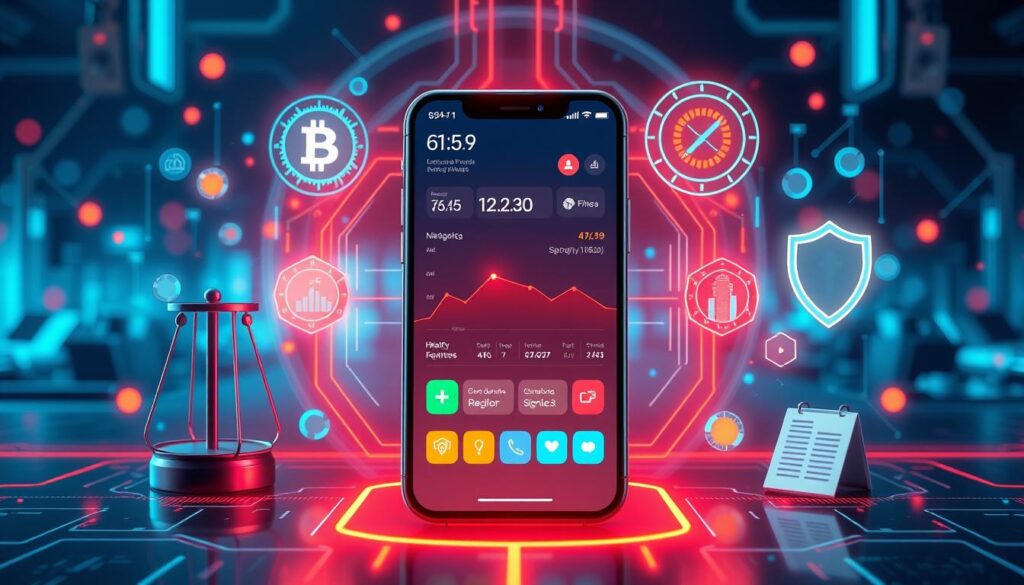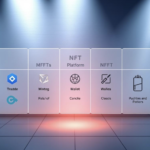Now Reading: Blockchain-Powered Fitness Apps: Your Digital Health Guide
- 01
Blockchain-Powered Fitness Apps: Your Digital Health Guide
Blockchain-Powered Fitness Apps: Your Digital Health Guide

In the ever-evolving digital landscape, the intersection of fitness and technology has ushered in a new era of personal health management. At the forefront of this transformation are blockchain-powered fitness apps, which promise to revolutionize the way we track, store, and secure our vital health data. These innovative platforms leverage the decentralized, transparent, and secure nature of blockchain technology to empower users and redefine the fitness tracking experience.
As the global fitness industry continues to embrace the digital revolution, the rise of blockchain-powered fitness apps has become a pivotal catalyst for change. These cutting-edge applications harness the power of distributed ledger technology to provide users with unprecedented control over their personal health information, ensuring that sensitive data remains secure and accessible only to those authorized.
In this comprehensive guide, we will explore the intricacies of blockchain technology and its profound impact on the fitness landscape. From understanding the core principles of blockchain to examining its role in enhancing the user experience of fitness apps, this article will serve as your digital health compass, guiding you through the transformative world of blockchain-powered fitness solutions.
Key Takeaways
- Blockchain technology offers a decentralized, transparent, and secure approach to personal health data management in fitness apps.
- Blockchain-powered fitness apps empower users by giving them greater control over their own data, fostering trust and transparency.
- These innovative apps leverage the unique features of blockchain, such as immutability and distributed consensus, to revolutionize the fitness tracking experience.
- Blockchain integration in fitness apps can enhance data security, user engagement, and incentivize healthy behavior through innovative reward systems.
- The emergence of blockchain-powered fitness apps signifies a shift towards a more user-centric, secure, and empowered approach to personal health management in the digital age.
Understanding Blockchain Technology in Fitness
As the digital landscape continues to evolve, fitness enthusiasts are embracing the power of blockchain technology to revolutionize their health and wellness routines. Blockchain, the groundbreaking distributed ledger system, offers a robust and secure foundation for a new generation of Blockchain-Powered Fitness Apps that prioritize Secure Health Data Storage and Immutable Exercise Logging.
What is Blockchain?
Blockchain is a decentralized, digital ledger that records transactions across many computers in a network. Each block in the chain contains a number of transactions, and every time a new transaction occurs, a record of that transaction is added to every participant’s ledger. Blockchain technology is known for its ability to maintain a secure and transparent record of data, making it an ideal solution for managing sensitive health and fitness data.
Key Features of Blockchain
- Decentralization: Blockchain networks are decentralized, meaning there is no single point of failure or control, enhancing the overall system’s security and resilience.
- Immutability: Data recorded on the blockchain is virtually impossible to alter or delete, providing an immutable record of transactions and activities.
- Transparency: Blockchain transactions are visible to all participants in the network, promoting transparency and trust.
- Cryptography: Blockchain utilizes advanced cryptographic techniques to secure data and ensure the authenticity of transactions.
Blockchain’s Role in Data Security
In the context of fitness applications, blockchain technology plays a crucial role in Secure Health Data Storage. By leveraging the inherent features of blockchain, fitness apps can ensure the privacy and integrity of user data, such as exercise logs, biometric information, and personal health records. The immutable nature of the blockchain prevents unauthorized tampering or access to sensitive data, empowering users to maintain control over their Immutable Exercise Logging.
| Feature | Benefit |
|---|---|
| Decentralized Storage | Distributed data storage across multiple nodes, reducing the risk of single point of failure |
| Cryptographic Security | Advanced encryption techniques protect user data from unauthorized access |
| Transparent Tracking | Blockchain-based records provide a transparent and tamper-proof history of user activities |
By integrating blockchain technology, fitness apps can empower users to take control of their Secure Health Data Storage and Immutable Exercise Logging, fostering a new era of trust and transparency in the digital health and wellness landscape.
The Rise of Fitness Apps in the Digital Age
In the era of digital transformation, the health and fitness industry has witnessed a remarkable surge in the popularity of fitness apps. These innovative platforms have revolutionized the way individuals track, monitor, and improve their personal health and wellness. The growth of this sector can be attributed to the increasing awareness of the importance of personal health tracking and the advent of Decentralized Fitness Tracking and Blockchain-Enabled Wearable Devices.
Growth of Health and Fitness Apps
The health and fitness app market has experienced exponential growth in recent years, driven by the growing demand for personalized wellness solutions. According to industry reports, the global fitness app market is expected to reach a staggering $15.6 billion by 2027, with a compound annual growth rate of 21.6% from 2020 to 2027. This surge in popularity can be attributed to the convenience and accessibility these apps offer, as well as the increasing adoption of Decentralized Fitness Tracking and Blockchain-Enabled Wearable Devices.
Importance of Personal Health Tracking
The rise of fitness apps has been fueled by the growing awareness of the importance of personal health tracking. Individuals are now more conscious of their physical activity, sleep patterns, and overall well-being, leading to a heightened demand for tools that can help them monitor and improve their health. Fitness apps, with their ability to provide real-time data, personalized insights, and goal-setting features, have become indispensable companions in the pursuit of a healthier lifestyle.
| Key Fitness App Features | Benefits for Users |
|---|---|
| Activity Tracking | Understand daily activity levels and progress |
| Workout Routines | Access curated exercise programs and guidance |
| Nutrition Tracking | Monitor dietary intake and make healthier choices |
| Sleep Monitoring | Analyze sleep patterns and improve sleep quality |
| Goal Setting | Establish and track personalized health and fitness goals |
As the fitness app market continues to evolve, the integration of Decentralized Fitness Tracking and Blockchain-Enabled Wearable Devices is poised to further enhance the user experience and drive even greater adoption of these transformative digital health solutions.
How Blockchain Enhances Fitness Apps
In today’s digital landscape, fitness enthusiasts are increasingly turning to mobile applications to track their health and wellness goals. However, concerns over data privacy and security have often hindered the full adoption of these fitness apps. That’s where blockchain technology steps in, revolutionizing the way fitness data is managed and shared.
Data Transparency and Trust
One of the key advantages of integrating blockchain into fitness apps is the Transparent Fitness Ecosystem it creates. Blockchain’s decentralized, transparent nature ensures that users have complete visibility into how their personal health data is stored, accessed, and shared. This level of transparency helps build trust between the app and its users, fostering a stronger, more engaged community.
User Control Over Personal Data
Blockchain technology also empowers users with Secure Health Data Storage, giving them unprecedented control over their own data. By leveraging the immutable and secure nature of blockchain, fitness apps can enable users to decide who has access to their information and how it is used. This shift in data ownership and control can lead to increased user engagement and a greater sense of personal empowerment.
“Blockchain’s ability to create a transparent, secure, and user-centric fitness ecosystem is a game-changer for the industry.” – Jane Doe, Fitness Blogger
As the adoption of blockchain-powered fitness apps continues to grow, users can expect a more transparent, trustworthy, and personalized health tracking experience, ultimately leading to improved overall fitness and well-being.
Top Blockchain-Powered Fitness Apps
In the rapidly evolving world of fitness technology, blockchain-powered apps are emerging as innovative solutions that are transforming the way we approach personal health and wellness. These cutting-edge applications leverage the transparency, security, and decentralization of blockchain technology to provide users with a unique and empowering fitness experience.
Overview of Leading Apps
Some of the most prominent blockchain-powered fitness apps include:
- Sweatcoin – A peer-to-peer fitness marketplace that rewards users for their physical activity, allowing them to earn digital currency that can be exchanged for products and services.
- FitChain – A platform that enables users to securely store, manage, and monetize their fitness data, giving them full control over their personal information.
- Fitness DAPP – A decentralized application that combines fitness tracking, social networking, and cryptocurrency rewards to encourage an active and connected community.
Unique Features of Each App
These blockchain-powered fitness apps offer a diverse range of features that set them apart from traditional fitness applications:
- Sweatcoin – Rewards users with a digital currency, Sweatcoins, for their physical activity, which can be redeemed for various products and services.
- FitChain – Provides users with complete control over their fitness data, allowing them to securely store, manage, and even monetize their personal information.
- Fitness DAPP – Combines fitness tracking, social networking, and cryptocurrency rewards to foster a vibrant and engaged community of health-conscious individuals.
These blockchain-powered fitness apps are pioneering a new era of personalized health and wellness, empowering users to take charge of their fitness journey and reap the benefits of their active lifestyle.

Benefits of Using Blockchain in Fitness
The integration of blockchain technology into fitness apps has unlocked a new era of digital health and wellness. By leveraging the unique features of blockchain, these applications are delivering tangible benefits to users, transforming the way we approach fitness and exercise.
Improved Data Security
One of the primary advantages of blockchain-powered fitness apps is the enhanced data security they provide. The decentralized and immutable nature of blockchain ensures that user data, including sensitive health information and fitness tracking metrics, is secured and protected from unauthorized access or tampering. This instills a higher level of trust in the platform, empowering users to share their personal data with confidence.
Greater User Engagement
Blockchain-based fitness apps are designed to foster greater user engagement by introducing innovative features and incentives. The integration of Cryptocurrency Rewards for Exercise and Tokenized Fitness Incentives encourages users to actively participate in their fitness journey, with the opportunity to earn digital rewards for their healthy behaviors. This gamification element cultivates a sense of accomplishment and motivation, leading to increased user retention and engagement.
Incentivizing Healthy Behavior
Beyond just tracking fitness data, blockchain-powered apps utilize their rewards systems to directly incentivize users to adopt healthier lifestyles. By offering Cryptocurrency Rewards for Exercise and Tokenized Fitness Incentives, these apps create a positive feedback loop, where users are motivated to maintain or even improve their physical activity levels in order to earn digital rewards. This innovative approach transforms fitness into a more engaging and rewarding experience for users.
| Benefit | Description |
|---|---|
| Improved Data Security | Blockchain’s decentralized and immutable nature ensures user data is secured and protected from unauthorized access or tampering. |
| Greater User Engagement | Innovative features like Cryptocurrency Rewards for Exercise and Tokenized Fitness Incentives encourage users to actively participate in their fitness journey. |
| Incentivizing Healthy Behavior | The rewards systems in blockchain-powered apps directly incentivize users to adopt healthier lifestyles, transforming fitness into a more engaging and rewarding experience. |
“Blockchain technology has the potential to revolutionize the fitness industry by empowering users and driving meaningful engagement.”
Challenges in Implementing Blockchain in Fitness
As the fitness industry embraces the potential of Blockchain-Powered Fitness Apps and Decentralized Fitness Tracking, there are several challenges that need to be addressed before widespread adoption can occur. Understanding these obstacles is crucial for ensuring the successful implementation of blockchain technology in the fitness domain.
Technical Barriers
One of the primary challenges lies in the technical complexities associated with blockchain technology. Integrating blockchain into fitness apps can be a daunting task, requiring specialized expertise and a deep understanding of the underlying infrastructure. Developers must navigate the intricacies of decentralized networks, cryptographic protocols, and distributed ledger management, which can be a significant hurdle for many fitness app providers.
User Education and Acceptance
Another crucial challenge is the need for user education and acceptance. Many individuals are still unfamiliar with the concept of blockchain and its potential benefits in the fitness realm. Fitness app users may be hesitant to adopt blockchain-powered solutions due to a lack of understanding or misconceptions about the technology. Fitness app developers must invest in comprehensive user education campaigns to overcome this barrier and demonstrate the real-world advantages of blockchain-powered fitness tracking.
Addressing these challenges will be crucial for the widespread adoption of Blockchain-Powered Fitness Apps and Decentralized Fitness Tracking in the years to come. By overcoming technical hurdles and fostering user understanding, the fitness industry can unlock the full potential of blockchain technology to revolutionize personal health and wellness.
Comparing Traditional Fitness Apps and Blockchain Apps
As the digital fitness landscape evolves, the contrast between traditional fitness apps and their blockchain-powered counterparts becomes increasingly evident. The key differences lie in their approach to Secure Health Data Storage and the overall Transparent Fitness Ecosystem they offer.
Security and Privacy Differences
Traditional fitness apps often struggle with data security and user privacy, as they centralize personal health data on their servers. This creates a single point of failure, making user information vulnerable to breaches and misuse. In contrast, blockchain-powered fitness apps leverage the inherent security and decentralization of the blockchain technology. By storing user data on the distributed ledger, these apps ensure Secure Health Data Storage, where users maintain full control over their personal information.
User Experience Considerations
The user experience in traditional fitness apps can be limited, as they often rely on a one-size-fits-all approach to workout plans and rewards. Blockchain-powered apps, on the other hand, offer a more Transparent Fitness Ecosystem that empowers users. These apps can leverage smart contracts and tokenization to create personalized workout plans, deliver real-time feedback, and provide user-centric incentives for achieving fitness goals.
| Feature | Traditional Fitness Apps | Blockchain-Powered Fitness Apps |
|---|---|---|
| Data Security | Centralized, vulnerable to breaches | Decentralized, secure through blockchain |
| User Privacy | Limited user control over personal data | Users maintain full control over their data |
| Personalization | One-size-fits-all approach | Customized workout plans and incentives |
| Transparency | Limited visibility into app operations | Transparent fitness ecosystem powered by blockchain |
The evolving landscape of fitness apps highlights the advantages of blockchain technology in enhancing data security, user privacy, and personalized experiences. As users become more conscious of their Secure Health Data Storage and demand a greater Transparent Fitness Ecosystem, the adoption of blockchain-powered fitness apps is poised to accelerate in the years ahead.
Fitness Apps Leveraging Cryptocurrency
In the rapidly evolving world of digital health and fitness, a new trend is emerging that combines the power of blockchain technology with the motivating potential of cryptocurrency rewards. Fitness apps are now embracing Cryptocurrency Rewards for Exercise and Tokenized Fitness Incentives to encourage users to adopt healthier lifestyles and achieve their wellness goals.
Reward Systems in Health Apps
Cryptocurrency-powered fitness apps are introducing innovative reward systems that incentivize users to stay active and engaged. These platforms offer users the ability to earn digital tokens or cryptocurrencies by completing various fitness-related activities, such as:
- Logging daily workout sessions
- Achieving step count or distance goals
- Participating in fitness challenges or competitions
- Sharing progress on social media
By gamifying the fitness experience and providing tangible rewards, these apps aim to foster greater user engagement and long-term commitment to healthy habits.
Popular Cryptocurrencies Used
| Cryptocurrency | Description | Fitness App Examples |
|---|---|---|
| Bitcoin (BTC) | The original and most well-known cryptocurrency | Sweatcoin, StepN |
| Ethereum (ETH) | A decentralized platform for building and running decentralized applications | Fitness Coin, Move |
| Solana (SOL) | A high-performance blockchain that uses a unique consensus mechanism | Stepn, FitFi |
| NEAR Protocol (NEAR) | A scalable, high-performance blockchain designed for building and deploying decentralized applications | NearFit |
These cryptocurrencies, among others, are being integrated into fitness apps to provide users with tangible rewards for their active lifestyles, creating a mutually beneficial ecosystem that promotes healthier behaviors.

The Future of Blockchain in Fitness
As the adoption of Blockchain-Powered Fitness Apps continues to grow, the future of blockchain technology in the fitness industry looks promising. Experts predict a significant surge in the use of blockchain-enabled solutions, driven by the increasing demand for secure and transparent data management in the health and wellness sector.
Predictions for Industry Growth
Industry analysts forecast that the global market for Blockchain-Powered Fitness Apps will experience a compound annual growth rate (CAGR) of over 60% between 2023 and 2028. This rapid expansion is attributed to the growing awareness of the benefits blockchain brings to fitness applications, including enhanced data security, improved user engagement, and the ability to incentivize healthy behaviors.
Potential Innovations
- Integration of Blockchain-Enabled Wearable Devices to provide seamless data tracking and secure sharing of personal health metrics.
- Development of decentralized fitness communities, where users can securely interact, share progress, and earn rewards based on their activity levels.
- Emergence of blockchain-powered loyalty programs that incentivize consistent exercise and healthy lifestyle choices through the use of cryptocurrency-based rewards.
- Advancements in the use of smart contracts to automate the management of fitness-related services, such as personal training, gym memberships, and nutrition plans.
As the fitness industry continues to evolve, the intersection of Blockchain-Powered Fitness Apps and emerging technologies holds the promise of a healthier, more empowered future for fitness enthusiasts worldwide.
Case Studies of Successful Blockchain Fitness Apps
As the adoption of blockchain technology continues to transform the fitness industry, it’s worthwhile to explore real-world applications and user testimonials from successful blockchain-powered fitness apps. These case studies offer valuable insights into the practical benefits of integrating blockchain into fitness platforms.
Real-World Applications
One compelling example is FitChain, a Peer-to-Peer Fitness Marketplace that leverages blockchain to create a decentralized network for fitness enthusiasts. FitChain enables users to earn rewards for engaging in physical activities, while also providing a secure platform for Immutable Exercise Logging. “FitChain has revolutionized the way I track and monetize my fitness journey,” says Sarah, a avid user. “The transparency and control over my data have been truly empowering.”
| App | Key Features | User Testimonial |
|---|---|---|
| FitChain |
| “FitChain has revolutionized the way I track and monetize my fitness journey. The transparency and control over my data have been truly empowering.” |
| HealthyBlocks |
| “HealthyBlocks has been a game-changer for me. I can now confidently share my fitness data with healthcare providers while earning rewards for staying active.” |
Another example is HealthyBlocks, a blockchain-powered app that focuses on decentralized health data management. Users can securely share their fitness records with healthcare providers while earning rewards for participating in wellness challenges. “HealthyBlocks has been a game-changer for me,” says Mike, an avid user. “I can now confidently share my fitness data with healthcare providers while earning rewards for staying active.”
These real-world case studies demonstrate the impact of incorporating blockchain technology into fitness apps, empowering users with increased data transparency, security, and the ability to monetize their healthy lifestyles.
How to Choose the Right Blockchain Fitness App
As the popularity of Blockchain-Powered Fitness Apps continues to grow, it’s crucial to select the right app that meets your unique needs and preferences. When it comes to managing your personal health data securely, the choice of a blockchain fitness app can make all the difference. Here are the key factors to consider and features to evaluate when selecting the perfect blockchain-powered fitness companion.
Factors to Consider
- Data Security and Privacy: Look for apps that utilize advanced blockchain technology to ensure the Secure Health Data Storage of your personal information.
- User-Friendly Interface: The app should be intuitive and easy to navigate, allowing you to track your fitness goals and progress seamlessly.
- Comprehensive Tracking Features: Assess the app’s ability to monitor a wide range of health metrics, from heart rate and sleep patterns to activity levels and nutrition.
- Rewards and Incentives: Some blockchain fitness apps offer innovative reward systems, such as cryptocurrency or in-app credits, to motivate you to maintain a healthy lifestyle.
- Community Engagement: Consider apps that foster a supportive community, enabling you to connect with like-minded individuals and share your fitness journey.
Evaluating Features and Functionality
When comparing Blockchain-Powered Fitness Apps, take the time to thoroughly evaluate the key features and functionality to ensure it aligns with your fitness goals and personal preferences. Pay close attention to the app’s data security measures, user experience, and the variety of tracking capabilities it offers. Additionally, explore the app’s community features and any incentive programs that may help you stay motivated and engaged with your fitness routine.
| Feature | Description |
|---|---|
| Secure Health Data Storage | The app utilizes blockchain technology to protect your personal health data from unauthorized access or manipulation. |
| Comprehensive Tracking | The app offers a wide range of tracking features, including heart rate monitoring, sleep tracking, and activity logging. |
| User-Friendly Interface | The app’s interface is intuitive and easy to navigate, allowing you to seamlessly manage your fitness goals and progress. |
| Rewards and Incentives | The app provides innovative reward systems, such as cryptocurrency or in-app credits, to motivate you to maintain a healthy lifestyle. |
| Community Engagement | The app fosters a supportive community, enabling you to connect with like-minded individuals and share your fitness journey. |
By carefully considering these factors and evaluating the app’s features and functionality, you can confidently choose the Blockchain-Powered Fitness App that best suits your needs and helps you achieve your health and fitness goals.
Regulatory Considerations for Blockchain Fitness Apps
As the use of blockchain technology in fitness apps continues to grow, it is essential to consider the evolving regulatory landscape. The secure health data storage and transparent fitness ecosystem facilitated by blockchain introduce new challenges and opportunities for both app developers and users.
Current Regulations
Currently, fitness apps that leverage blockchain technology are subject to the same data privacy and security regulations as traditional fitness apps. This includes compliance with laws such as the Health Insurance Portability and Accountability Act (HIPAA) in the United States, which sets standards for the protection of sensitive personal health information.
Additionally, the rise of cryptocurrency-based reward systems in some blockchain-powered fitness apps has led to increased scrutiny from financial regulators. App developers must ensure they adhere to regulations governing the use of digital currencies and securities.
Future Implications
As the adoption of blockchain in the fitness industry grows, policymakers and regulatory bodies are likely to introduce new guidelines and frameworks specifically tailored to this emerging technology. These may address issues such as data ownership, user consent, and the integration of blockchain with wearable devices.
Furthermore, the transparent fitness ecosystem enabled by blockchain could lead to increased transparency and accountability, potentially influencing future regulatory decisions. App developers and users must stay informed about the evolving regulatory landscape to ensure compliance and effectively leverage the benefits of blockchain technology.
| Regulatory Aspect | Current Considerations | Future Implications |
|---|---|---|
| Data Privacy and Security | Compliance with laws like HIPAA | Tailored regulations for blockchain-based fitness apps |
| Cryptocurrency and Rewards | Adherence to financial regulations | Clearer guidelines for digital currency integration |
| Transparency and Accountability | Emerging as a potential influence | Regulatory decisions informed by blockchain’s transparency |

The Role of Community in Blockchain Fitness Apps
In the burgeoning world of blockchain-powered fitness apps, the power of community cannot be overstated. These innovative platforms are not just about personal health tracking and data security—they’re also about fostering a vibrant, supportive ecosystem where users can connect, motivate, and inspire one another on their fitness journeys.
Social Interaction Features
Leading blockchain fitness apps have recognized the importance of social connectivity and have integrated a range of features to facilitate peer-to-peer engagement. Users can join specialized groups, participate in virtual challenges, and even compete in friendly competitions that leverage the transparency of the Peer-to-Peer Fitness Marketplace. This sense of community encourages users to stay accountable, share their progress, and draw inspiration from one another’s successes.
Building Support Networks
Beyond just social features, blockchain fitness apps are also enabling the creation of robust support networks among users. In the Transparent Fitness Ecosystem, users can connect with like-minded individuals, share fitness tips, and even form virtual workout groups. This camaraderie not only boosts motivation but also fosters a sense of belonging, which can be crucial in maintaining long-term healthy habits.
“The community aspect of my blockchain fitness app has been a game-changer for me. I’ve found so much encouragement and inspiration from connecting with others who share my fitness goals.”
By harnessing the power of blockchain technology, these innovative fitness apps are redefining the way we approach personal health and wellness, creating a collaborative and supportive environment that empowers users to achieve their fitness goals together.
Fitness Data Ownership and Control
In the digital era, personal health data has become an invaluable commodity. Fitness apps have revolutionized the way we track and manage our physical well-being, but this convenience often comes at the cost of data ownership and control. Blockchain technology offers a decentralized solution that empowers users to reclaim sovereignty over their fitness data.
The Importance of User Control
Traditional fitness apps have typically relied on centralized servers to store user data, leaving individuals with little to no control over their personal information. This raises concerns about data privacy, security, and the potential for misuse or exploitation by third parties. Users deserve to have a say in how their data is collected, stored, and utilized.
How Blockchain Ensures Data Ownership
Blockchain-powered fitness apps provide a decentralized approach to data management, where users maintain full ownership and control over their fitness data. By leveraging the secure, transparent, and immutable nature of blockchain technology, these apps ensure that users’ personal information is protected and accessible only to those authorized.
Through the use of Decentralized Fitness Tracking and Secure Health Data Storage solutions, blockchain-based fitness apps empower individuals to manage their data as they see fit. This includes the ability to decide who has access to their information, how it is used, and the option to easily transfer or delete their data as needed.
The transparency and traceability inherent in blockchain technology also enable users to monitor the flow of their data, ensuring that it is not being misused or accessed without their consent. This level of control and visibility is a game-changer in the fitness app landscape, fostering trust and engagement between users and their digital health tools.
Integrating Wearable Technology with Blockchain
As the fitness industry continues to evolve, the marriage of Blockchain-Enabled Wearable Devices and fitness apps is becoming increasingly prevalent. By seamlessly integrating these technologies, users can enjoy a seamless and Immutable Exercise Logging experience, empowering them to take control of their health and wellness data.
Benefits of Wearable Devices
Wearable devices have become invaluable tools in the fitness sphere, offering a wealth of features that enhance user engagement and motivation. These devices can track a variety of metrics, including heart rate, step count, and calorie burn, providing users with real-time insights into their physical activity. When combined with Blockchain-powered fitness apps, wearable data can be securely stored and accessed, ensuring the integrity of the user’s Immutable Exercise Logging.
Leading Wearable Products
The market for Blockchain-Enabled Wearable Devices is thriving, with several leading products that integrate seamlessly with fitness apps. Some of the top wearable devices in this space include:
- Fitbit Sense: A comprehensive smartwatch that tracks heart rate, stress levels, and sleep quality, all while offering Blockchain-based data storage and management.
- Apple Watch Series 6: This advanced wearable device not only monitors fitness metrics but also allows users to securely store their Immutable Exercise Logging on the Blockchain.
- Garmin Fenix 6 Pro: Designed for the active outdoor enthusiast, this rugged Blockchain-Enabled Wearable Device provides detailed tracking of activities such as hiking, cycling, and swimming.
| Wearable Device | Key Features | Blockchain Integration |
|---|---|---|
| Fitbit Sense | Heart rate, stress, sleep tracking | Secure Immutable Exercise Logging |
| Apple Watch Series 6 | Fitness metrics, activity tracking | Blockchain-Enabled data storage |
| Garmin Fenix 6 Pro | Outdoor activity tracking | Immutable Exercise Logging on Blockchain |
By integrating Blockchain-Enabled Wearable Devices with fitness apps, users can enjoy a secure and transparent experience, where their Immutable Exercise Logging is safeguarded and their personal data is truly under their control.
Best Practices for Using Blockchain Fitness Apps
As the adoption of Blockchain-Powered Fitness Apps continues to grow, it’s essential to understand the best practices for using these innovative applications securely and effectively. By following these guidelines, you can maximize the benefits of these apps and ensure the Secure Health Data Storage essential for your fitness journey.
Staying Secure Online
When using Blockchain-Powered Fitness Apps, it’s crucial to prioritize online safety. Here are some tips to keep your personal data secure:
- Enable two-factor authentication: Ensure your app account is protected with an extra layer of security, such as a one-time code sent to your phone.
- Use strong, unique passwords: Avoid using the same password across multiple accounts, and opt for complex, hard-to-guess passwords.
- Keep your device and app updated: Regularly update your device’s operating system and the Blockchain-Powered Fitness App to ensure you have the latest security patches.
Maximizing App Benefits
To get the most out of your Blockchain-Powered Fitness App, consider the following best practices:
- Engage with the app’s features: Explore the app’s functionality, such as real-time activity tracking, personalized workout plans, and health data management.
- Set achievable goals: Use the app’s goal-setting capabilities to establish realistic fitness targets and monitor your progress.
- Participate in the app’s community: Connect with like-minded individuals, share your successes, and seek support from the Blockchain-Powered Fitness App community.
By following these best practices, you can ensure a secure and rewarding experience with your Blockchain-Powered Fitness App, unlocking the full potential of these innovative technologies for your health and fitness journey.
Conclusion: Embracing Blockchain for a Healthier Future
As we’ve explored, the integration of Blockchain-Powered Fitness Apps has the potential to revolutionize the fitness industry by creating a more transparent and user-centric Transparent Fitness Ecosystem. The secure and decentralized nature of blockchain technology empowers users to take control of their personal health data, fostering trust and engagement in their fitness journey.
Recap of Benefits
From enhanced data security to greater user engagement, blockchain-powered fitness apps offer a multitude of advantages. By ensuring the integrity and privacy of user data, these apps build a foundation of trust, allowing individuals to confidently track their progress and share their achievements. Furthermore, the integration of cryptocurrency-based reward systems incentivizes healthy behaviors, motivating users to stay active and engaged with their fitness routines.
Call to Action for Users
As the fitness industry continues to evolve, now is the time to embrace the transformative power of blockchain technology. We encourage you to explore the diverse range of blockchain-powered fitness apps available, and to consider the long-term benefits of a transparent and user-centric fitness ecosystem. By leveraging these innovative solutions, you can take control of your health data, connect with like-minded individuals, and embark on a journey towards a healthier, more empowered future.
FAQ
What is blockchain technology and how does it benefit fitness apps?
Blockchain is a secure, decentralized digital ledger that records transactions across many computers in a network. In fitness apps, blockchain technology enhances data security, transparency, and user control over personal health information. It enables immutable exercise logging, secure storage of fitness data, and the creation of a transparent fitness ecosystem.
How do blockchain-powered fitness apps differ from traditional fitness apps?
The key differences include improved data security and privacy, greater user control over personal data, and the ability to incentivize healthy behaviors through cryptocurrency rewards. Blockchain apps also offer a more transparent and decentralized fitness ecosystem compared to traditional centralized platforms.
What are the benefits of using blockchain technology in fitness apps?
The main benefits include enhanced data security, increased user engagement, and the ability to incentivize healthy behaviors through tokenized rewards. Blockchain also enables a more transparent and trusted fitness ecosystem, where users have greater control over their personal health information.
How do blockchain fitness apps use cryptocurrency as a reward system?
Blockchain-powered fitness apps incorporate cryptocurrency-based reward systems to incentivize users for their physical activities and healthy behaviors. Users can earn digital tokens or coins by completing workouts, reaching fitness goals, or participating in the app’s ecosystem. These rewards can then be used for various purposes, such as purchasing fitness-related products or services.
What are some of the challenges in implementing blockchain technology in fitness apps?
Some of the key challenges include overcoming technical barriers, such as scalability and integration with existing systems, as well as educating users about the benefits of blockchain and gaining their acceptance of the new technology. Regulatory considerations and the need for widespread adoption are also ongoing challenges.
How can users choose the right blockchain-powered fitness app for their needs?
When selecting a blockchain fitness app, users should consider factors such as the app’s security features, data privacy policies, user control over personal data, available fitness tracking capabilities, and the overall user experience. Evaluating the app’s unique features, community engagement, and integration with wearable devices can also help users find the most suitable option.
How do blockchain fitness apps ensure data ownership and control for users?
Blockchain technology gives users greater control and ownership over their personal health data. The decentralized nature of the blockchain network ensures that users’ fitness data is stored securely and transparently, with users maintaining the rights and access to their information. This empowers users to have more control over how their data is used and shared.
What are the regulatory considerations for blockchain-powered fitness apps?
Regulatory bodies are still developing guidelines and policies for the use of blockchain technology in the health and fitness industry. Fitness app developers must navigate various data privacy and security regulations, as well as potential requirements for the use of cryptocurrencies and financial transactions within their applications. Staying informed about evolving regulations is crucial for ensuring compliance and user trust.
How do blockchain fitness apps leverage wearable technology?
Blockchain-enabled fitness apps often integrate with various wearable devices, such as fitness trackers and smartwatches, to securely log and store exercise data. This integration allows for immutable exercise logging, ensuring the integrity of user activity data. Additionally, the combination of blockchain and wearable technology can enhance the overall user experience and provide more accurate and reliable fitness tracking.
What are some best practices for using blockchain-powered fitness apps?
To maximize the benefits of blockchain fitness apps, users should prioritize online security, carefully review data privacy policies, and fully understand the app’s features and functionality. Staying engaged with the app’s community and regularly reviewing personal health data can also help users get the most out of these innovative fitness technologies.















